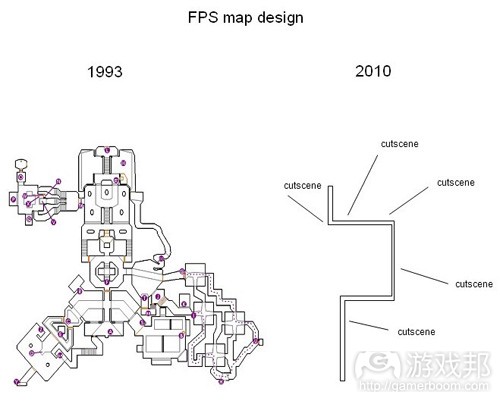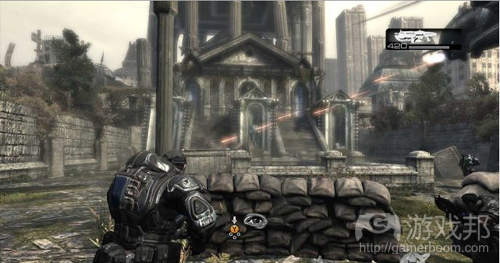解析游戏设计5大现实谬论之世界设计
作者:Josh Bycer
在本系列的最后一部分,我们来看看现代AAA游戏中的世界。回顾较早以前的现实题材的游戏,我们会发现许多失真的设计,但我们必须忽略不计,因为技术还不成熟。
但现在,有了先进的图像引擎和花在开发上的数百万美元,游戏世界的设计在真实感上,仍然让人觉得没有多大突破。
只有一条出路
我们从关卡设计的宏关层面开始说起。问FPS粉丝,过去的关卡设计和现在的关卡设计的最大变化是什么,他们的回答可能接近于下图所示:
虽然制图方面显然有了质的飞跃,但通过这些关卡的实际路径基本上只有一条。在那些发生地点为丛林或郊外的游戏中,这一点就更加明显了。
在《神秘海域》系列中,玩家想迷路都难,因为丛林和废墟都小得不真实。在发生地点为城市的游戏中,几乎所有街道走到底都会被各种东西堵上,迫使玩家折回那一两条特定的街道。
这么做显然是为了引导玩家从一个场景走向另一个场景,使游戏以某个稳定的节奏展开。但这导致关卡缺乏深度,游戏世界失真。
更不要说,角色不能爬过碎石堆、不能跳过小沟等,这些是完全没道理的。另一个更让人恼火的例子是,让玩家探索某个村庄或城市,但除了其中一扇门,其他门都上锁了。如果我带着军用级别的武器,为什么我不能一枪把门打爆?这不科学。
最古老的障碍就是可怕的“看不见的墙”,许多游戏中都有,但从来没有人能解释为什么角色走到边上就停下了。不过,随着关卡设计的优化,设计师困住玩家的办法也更高明了,这意味着“看不见的墙”的使用将减少。
我还要抱怨的另一个东西是可收集的道具,考虑到我是一个爱收集道具的人,我会痛斥道具确实有点奇怪了。我要说的问题是,在大多数游戏中,可收集道具并不符合游戏的主题。
你告诉我很久很久以前,人们把各种小玩意藏在一个现实中没有人会去的地方?我要赞扬一下《蝙蝠侠之阿卡姆疯人院》系列,Rocksteady想出一个似乎合理的办法来处理可收集道具,也就是使用谜天奖杯(Riddler Trophies)。
寻找可收集的道具是最容易与游戏主题发生冲突的玩法之一。在我与Arcen Games的Chris Park讨论《Shattered Haven》时,我告诉他我如何因为走了错路而破坏了游戏。
他笑道,他没有料到跟着剧情走的人会偏离目标。但是,按照玩家的逻辑,设计师总是把最好的东西藏在最人迹罕至的地方,这就导致玩家故意走错路。
在一个玩家要与时间赛跑的故事中,走遍每个走廊去寻找一件高级装备往往与主题相冲突。然而,在游戏这么一个事物的宏大组合中,这个问题或多或少是个不可避免的邪恶,毕竟专家级玩家需要更多挑战和可做的事。
接下来我们再来说说游戏世界是谁建造的,以及游戏世界如何运作。
失真的物理
当谈论游戏物理时,我的想法总是比较挑剔。然而,当设计师试图建立一个逼真的游戏世界时,任何不适当的东西都会比在卡通或风格化的背景中更加显得显得突出。
在现实主义游戏中,我最反感的细节有三个。第一个是,箱子像小车一样坚固,小车像水泥墙一样坚固,水泥墙坚不可摧(游戏邦注:降非它们被标记是可以摧毁的)。
电子游戏中的绝大部分物品纯粹是静止的摆设。
当玩家可以永远躲在高墙后面,不必担心被炮弹打飞,游戏的沉浸感立即被破坏了。
(高墙的坚不可摧是射击游戏设计中的准则,无论这个设计有多么失真。)
这个细节是多人游戏实现平衡的要点,就好像一名玩家可以破坏所有掩蔽物,这样他就轻易占上风了。但如果你做的是一款有沉浸感的单机游戏,那么你就得改进体验了。
第二个细节是物理和关卡设计相结合。正如我们在前面说过的,关卡设计越来越线性,设计师利用各种障碍来限制玩家的探索活动。
结果是,移动的角色困在不能活动的世界里。例子有很多,比如不能翻过及胸高的墙,只能爬过游戏指定的一面墙等。
这些元素在破坏了玩家探索世界的幻觉,向玩家揭示这个环境其实有多么局限。
最后,最让我不满的是:在FPS中,屏幕上只能显示手臂。我理解大多数时候,这么做是出于技术原因,因为这样程序员就不必担心渲染和动画的问题了。但当你在讲述一个严肃的故事时,你的角色只是一双漂浮的手臂,那就太可笑了。
另一个问题虽然不至于让我生气,但也应该提一提,那就是糟糕的布娃娃效果。在许多FPS中,我们都可以看到这个现象,当敌人挂掉,身体一落地就消失了,或者当发生大爆炸时,敌人的尸体像车轮似地腾空前进30尺。
现在,这可能可以当成一件好事,因为移除死人的尸体可以减轻暴力色彩。一个相反的例子是《命运战士》系列,这款游戏模拟死亡和伤害的动画非常逼真,可以看到霰弹轰爆敌人四肢的血腥画面。
次世代主机不久将推出,意味着对游戏的设计和画面将有更大的真实感。在游戏开发者努力打造更有深度的故事和利用所有先进的技术时,务必记得玩法也要跟上。
上述提到的元素涵盖了我们坚持不放的游戏设计的五个残余部分。但愿在肩负着革命游戏产业的次世代游戏,特别是AAA游戏中,我们能看到真正摆脱了这些失真原则的游戏。
(本文为游戏邦/gamerboom.com编译,拒绝任何不保留版权的转载,如需转载请联系:游戏邦)
5 Realistic Fallacies in Game Design: World Design
By Josh Bycer
We come to the final part for this series examining the worlds that modern AAA titles are built on. When we look at older series that tried to take place in the real world, there were a lot of unrealistic aspects of game design we had to ignore due to the fact that technology wasn’t at the point to show it all.
But with today’s graphics engines and millions spent on development, world design still feels trapped in the past.
All Roads Lead to Linearity:
Let’s start at the macro level with level design. Ask a First Person Shooter fan the biggest change between level design back then and today and they’ll probably point to this picture:
FPSdesign 300×234 5 Realistic Fallacies in Game Design: World Design
While graphics have definitely gotten more advanced, the actual paths through these levels are majority one-way. This becomes all the more noticeable with games that take place in jungles or out in the country.
The Uncharted series for instance makes it very hard for the player to get lost as the jungles and ruins are unrealistically small. In games that take place in cities, you’ll find that almost every street is blocked in some way or the other, forcing the player down one or two specific roads.
These changes were done explicitly do guide the player from one set piece to another and keep the experience going at a steady pace. But this makes the levels lack depth and prevents the world from having any sense of geography.
Not to mention the fact that it made no sense that these characters can’t climb over rubble, jump small gaps and so on. One of the more annoying tropes was having a village or city to explore, but every door except for one was unlocked. If I’m carrying military grade weapons, then there should be no reason why I can’t shoot apart a wooden door.
One of the oldest barriers would be the dreaded “invisible walls” which for being included in so many games, is never explained why the character decides to just stop. Granted, as level design has become streamlined, the designers do a better job of corralling the player through the level which means less reason to use invisible walls.
Another gamey trope is collectibles which complaining about them is odd for me, considering that I’m one of those guys who will go after them. The problem with collectibles in most games is that they clash with the theme of the world and general geography.
You’re telling me that a long time ago that people decided to hide various knick knacks in areas that no one would realistically go? I will give credit to Rocksteady for the Batman Arkham series for figuring out a plausible way of doing collectibles with the use of the Riddler trophies.
Collectible hunting is one of those elements of gameplay that clash with the theme of the game. During our podcast with Chris Park from Arcen Games on Shattered Haven, I told him about how I broke the game by going the wrong way.
He laughed and said that he didn’t expect people who were following the story to go away from the goal. But then again, gamer logic dictates that the designers always hide the best stuff off the beaten track, training players to go the wrong way on purpose.
When designing a story that the player is supposed to be on a time-table, going down every corridor to find a mc-guffin tends to clash with that. However in the grand scheme of things, this issue is more or less considered a necessary evil to add more challenges and things for expert players to do.
Let’s move on from who the world is built and talk about how the world works.
Physics Frustration:
When we talk about game physics, this is where my thoughts land on the side of nit-picking. However when a designer is trying to create a realistic world, anything that seems out of place will stand out that much more compared to a cartoony or stylized setting.
There are three details that annoy me whenever I catch them in a “realistic” game. First is how boxes have the same density as cars that have the same as cement walls and so on, unless they were marked as destructible.
Indestructible chest high walls have become the norm for cover in shooter design, no matter how unrealistic.
The majority of objects placed in video games is considered static and are simply window dressing.
Such as when someone can hide behind a chest high wall for eternity which easily breaks immersion.
This detail is a big point about multiplayer balance, as if one player could just destroy all the cover; it would make it very easy for someone to dominate. But if you’re trying to create an engaging single player title, then you want to keep shaking up the experience.
The second detail is a combination of physics and level design. As we talked about in the first part, level design has become increasingly more linear and designers use a variety of obstacles to limit exploration.
What ends up happening is that we have a mobile character stuck in an immobile world. With many examples such as not being able to jump over chest high walls, the ability to only climb up select walls in the environment and so on.
These elements break the illusion that you are exploring a setting and instead show just how constrained the environment really is.
Finally the most “nit-picky” of the three for me: First Person Shooters where only the arms are being rendered on screen. I understand that most of the time, this is done for technical reasons as it is one less thing the programmer needs to worry about rendering and animating. But when you’re trying to tell a serious story having your character be just a floating pair of arms contradicts that.
Another issue is if your game has jumping segments, as it is harder to gauge your jumps when there are no legs to show your position on a ledge.
One other issue that doesn’t annoy me but has to be mention is crazy rag-doll effects. We see this in many First Person Shooters where the second an enemy dies their body spazs out as it falls to the ground, or when an explosive sends an enemy’s corpse cart-wheeling thirty feet in the air.
Now this could be debated as a good thing, as removing the reality from killing humans makes it seem less violent. One example of the opposite would be the Soldier of Fortune series which modeled realistic death and damage animations to human enemies such as being able to blow off limbs with a shotgun.
The next generation of consoles is coming soon and that means that the push for greater realism and graphical fidelity will also follow. As game makers strive to tell deeper stories and make use of all the technological advantages we have, it’s important to remember the gameplay.
The elements I’ve discussed over these five parts are all remnants of game design that we still cling to. For the next generation to truly revolutionize the industry, specifically AAA development, hopefully we’ll start seeing games that break away from these norms.(source:game-wisdom)










































 闽公网安备35020302001549号
闽公网安备35020302001549号